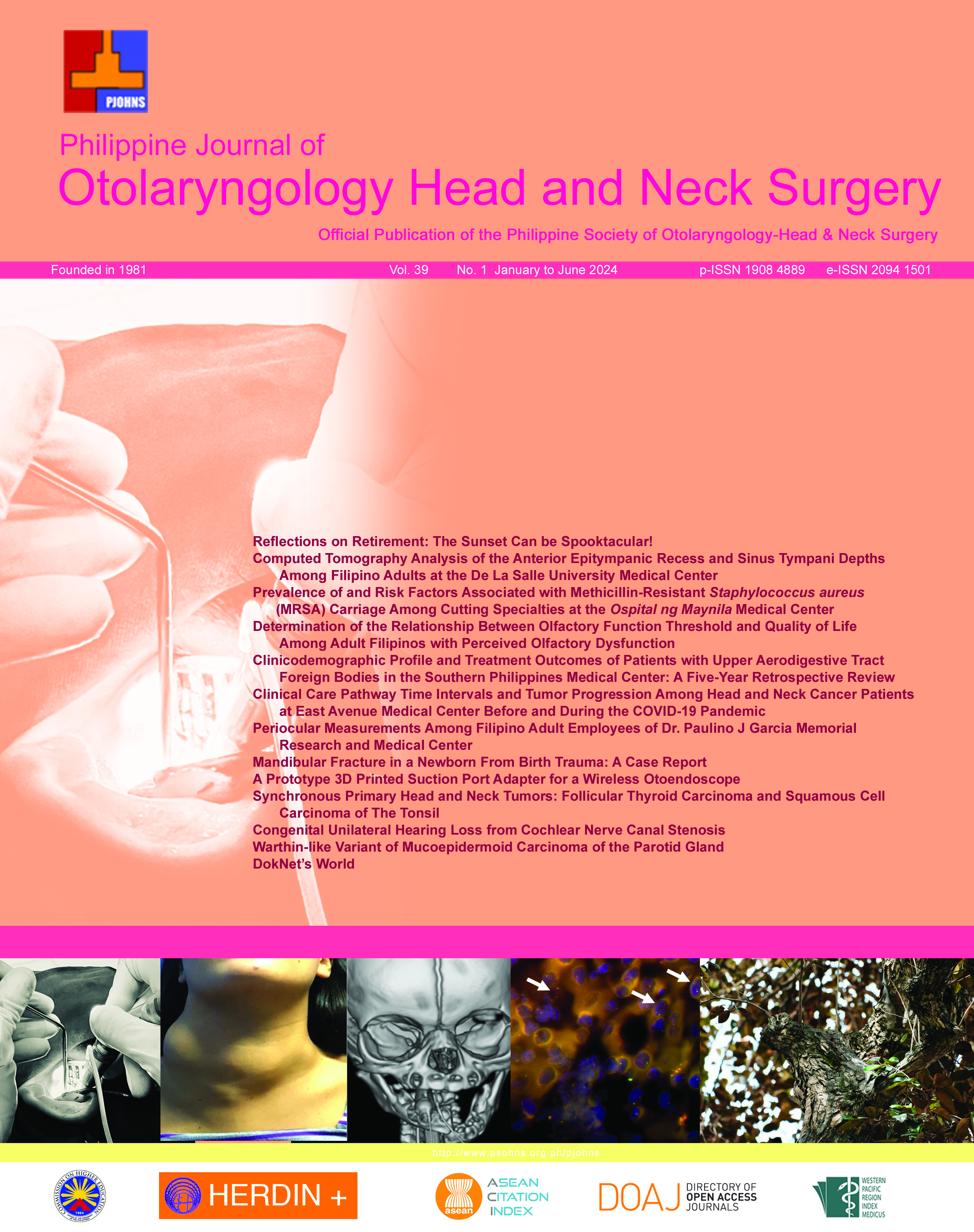Determination of the Relationship Between Olfactory Function Threshold and Quality of Life Among Adult Filipinos with Perceived Olfactory Dysfunction
DOI:
https://doi.org/10.32412/pjohns.v39i1.2179Keywords:
olfactory dysfunction, threshold, smell, quality of life, QOD-NS, BTTAbstract
Objective: To determine the relationship between olfactory function threshold and quality of life (QOL) among adult Filipinos with perceived olfactory dysfunction (OD).
Methods:
Design: Cross - Sectional Study
Setting: Tertiary Government Training Hospital
Participants: 98 adults who had self-perceived olfactory dysfunction described as “poor” or “no sense” of smell
Results: We analyzed data from 98 participants, with a mean age of 35.91 + 12.58 years old, composed of 46 men (47%) and 52 women (53%), with 82 normosmic, six hyposmic and ten anosmic as categorized by their BTT scores. Twenty-seven percent (27%) identified themselves as having poor QOL based on Fil 17 QODNS. Differences were exhibited between sexes’ BTT scores - [t(96) = -2.32; p = .022; females, M: 9.25; SD: 2.33 vs. males, M: 7.76; SD : 3.91], civil status Fil17QODNS scores [t(96)= 3.05, p < .003; married M: 11.72, SD: 13.74 vs. single, M: 4.71; SD: 8.66), and the presence of ENT symptoms BTT [t(96) = -7.15; p < .0001; symptomatic, M: 5.62; SD: 4.54, vs. asymptomatic, M: 9.78; SD: 1.14] and Fil 17 QODNS scores [t(96)= 3.94; P < .00001; symptomatic, M: 14.86; SD: 13.97] vs. asymptomatic, M: 5.217; SD: 9.60]. Significant risk factors were the presence of ENT symptoms [OR= 0.15; 95% CI: 0.02-0.97; P = .046] for poor smell threshold, and comorbidities [OR= 3.36; 95% CI: 1.04-10.85; P = .043] for poor QOL. A negative correlation was observed between Fil-QOD-NS scores and BTT scores [r = -0.477, p < .001; rs = -0.292, p = .004], signifying that the presence of olfactory dysfunction has an inverse relationship
with the quality of life.
Conclusion: Individuals with olfactory dysfunction in this study population had poor quality of life as determined by the translated Filipino 17-item QOD-NS which has an inverse relationship with their smell threshold as represented by the BTT results. Among the factors studied, significant differences were found between sexes, civil status and presence of ENT symptoms in the BTT and Fil 17 QODNS scores. However, only presence of comorbidities and ENT symptoms are significant risk factors for quality of life and smell threshold, respectively, in this population.
Downloads
Published
How to Cite
Issue
Section
Categories
License
Copyright (c) 2024 Publisher

This work is licensed under a Creative Commons Attribution-NonCommercial-NoDerivatives 4.0 International License.
Copyright transfer (all authors; where the work is not protected by a copyright act e.g. US federal employment at the time of manuscript preparation, and there is no copyright of which ownership can be transferred, a separate statement is hereby submitted by each concerned author). In consideration of the action taken by the Philippine Journal of Otolaryngology Head and Neck Surgery in reviewing and editing this manuscript, I hereby assign, transfer and convey all rights, title and interest in the work, including copyright ownership, to the Philippine Society of Otolaryngology Head and Neck Surgery, Inc. (PSOHNS) in the event that this work is published by the PSOHNS. In making this assignment of ownership, I understand that all accepted manuscripts become the permanent property of the PSOHNS and may not be published elsewhere without written permission from the PSOHNS unless shared under the terms of a Creative Commons Attribution-NonCommercial-NoDerivatives 4.0 International (CC BY-NC-ND 4.0) license.



